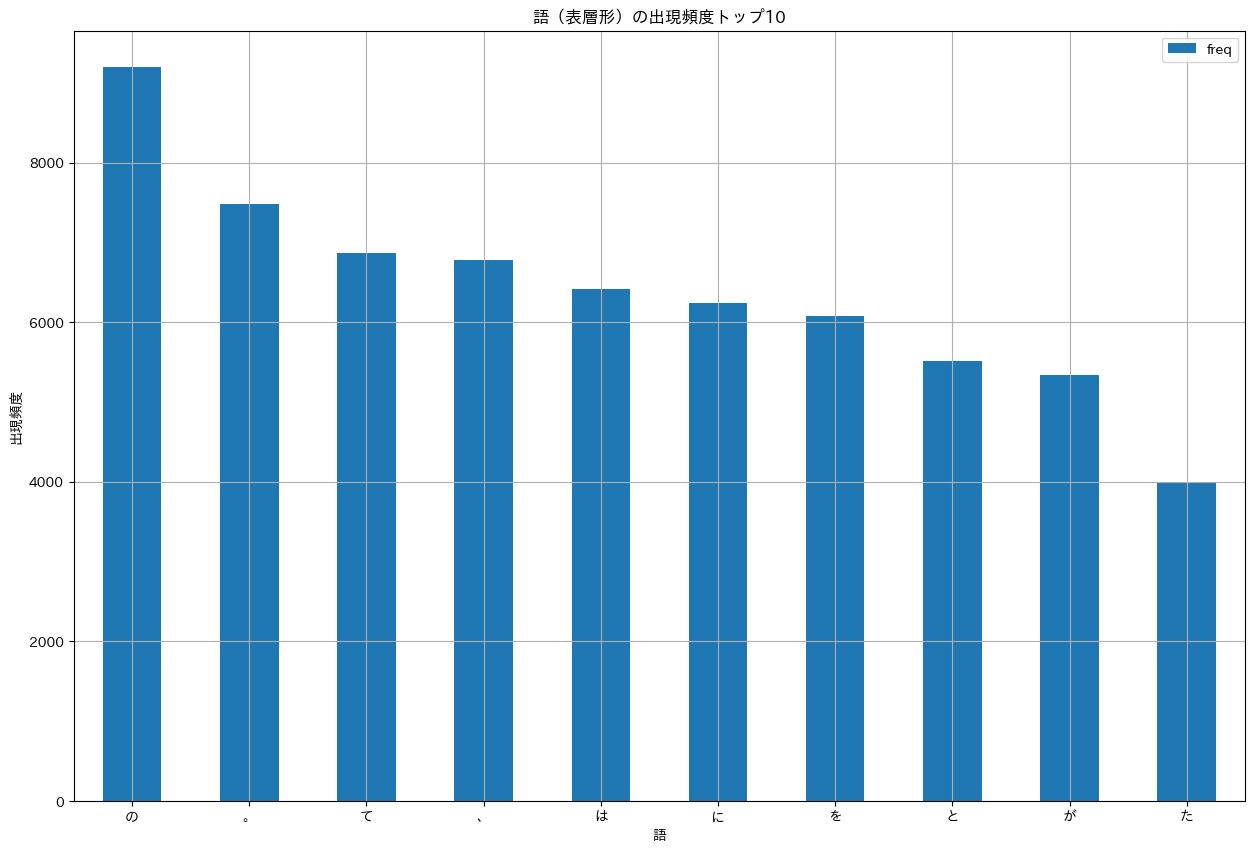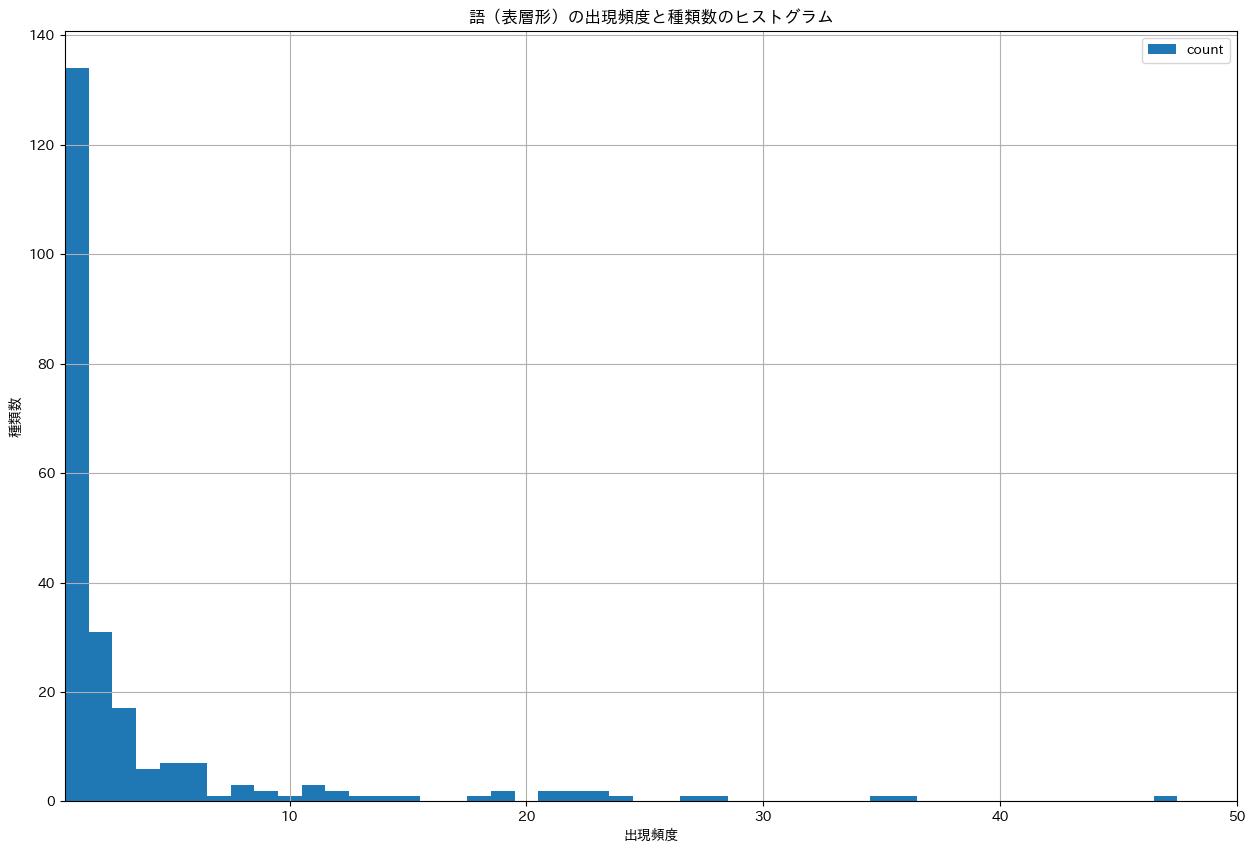Chapter 4 POS Tagging
夏目漱石の小説『吾輩は猫である』の文章(neko.txt)を MeCab を使って形態素解析し, その結果を neko.txt.mecab というファイルに保存せよ. このファイルを用いて, 以下の問に対応するプログラムを実装せよ.
なお,問題37, 38, 39は matplotlib もしくは Gnuplot を用いるとよい.
>>> from pathlib import Path
>>> import MeCab
>>> import requests
>>> NEKO_TEXT = 'neko.txt'
>>> NEKO_TEXT_URL = f'http://www.cl.ecei.tohoku.ac.jp/nlp100/data/{NEKO_TEXT}'
>>> NEKO_TEXT_MECAB_FILEPATH = Path(f'./{NEKO_TEXT}.mecab')
>>> response = requests.get(NEKO_TEXT_URL)
>>> lines = (response.content.decode('utf-8')
... .split())[1:] # Ignore the beginning of document
>>> m = MeCab.Tagger()
>>> pos_tagged_lines = list(map(m.parse, lines))
>>> with NEKO_TEXT_MECAB_FILAPTH.open('w') as f:
... f.writelines(pos_tagged_lines)
30. 形態素解析結果の読み込み
形態素解析結果(neko.txt.mecab)を読み込むプログラムを実装せよ. ただし, 各形態素は表層形(surface), 基本形(base), 品詞(pos), 品詞細分類1(pos1)をキーとするマッピング型に格納し, 1文を形態素(マッピング型)のリストとして表現せよ. 第4章の残りの問題では, ここで作ったプログラムを活用せよ.
>>> from pprint import pprint
>>> import re
>>> POS_TAG = ','.join(['(.+)'] * 9)
>>> MECAB_POS_PATTERN = re.compile(f'(.+)\t{POS_TAG}')
>>> with POS_TAGGED_NEKO_TEXT_FILAPTH.open() as f:
... text = f.read()
... sentences = text.split('EOS\n')
>>> pos_tagged_sentences = []
>>> for sentence in sentences[:-1]:
... lines = sentence.split('\n')[:-1]
... pos_tagged_tokens = []
... for line in lines:
... matched = MECAB_POS_PATTERN.match(line)
... if matched:
... pos_tagged_token = {
... 'surface': matched.group(1),
... 'base': matched.group(8),
... 'pos': matched.group(2),
... 'pos1': matched.group(3)
... }
... pos_tagged_tokens.append(pos_tagged_token)
... pos_tagged_sentences.append(pos_tagged_tokens)
>>> pprint(pos_tagged_sentences)
[[{'base': '吾輩', 'pos': '名詞', 'pos1': '代名詞', 'surface': '吾輩'},
{'base': 'は', 'pos': '助詞', 'pos1': '係助詞', 'surface': 'は'},
{'base': '猫', 'pos': '名詞', 'pos1': '一般', 'surface': '猫'},
{'base': 'だ', 'pos': '助動詞', 'pos1': '*', 'surface': 'で'},
{'base': 'ある', 'pos': '助動詞', 'pos1': '*', 'surface': 'ある'},
{'base': '。', 'pos': '記号', 'pos1': '句点', 'surface': '。'}],
[{'base': '名前', 'pos': '名詞', 'pos1': '一般', 'surface': '名前'},
{'base': 'は', 'pos': '助詞', 'pos1': '係助詞', 'surface': 'は'},
{'base': 'まだ', 'pos': '副詞', 'pos1': '助詞類接続', 'surface': 'まだ'},
...
31. 動詞
動詞の表層形をすべて抽出せよ.
>>> from itertools import chain
>>> pos_tagged_tokens = list(chain.from_iterable(pos_tagged_sentences))
>>> verb_surfaces = [
... pos_tagged_token['surface'] for pos_tagged_token in pos_tagged_tokens if pos_tagged_token['pos'] == '動詞'
... ]
>>> pprint(verb_surfaces)
['生れ',
'つか',
'し',
'泣い',
'し',
...
32. 動詞の原形
動詞の原形をすべて抽出せよ.
>>> verb_bases = [
... pos_tagged_token['base'] for pos_tagged_token in pos_tagged_tokens if pos_tagged_token['pos'] == '動詞'
... ]
>>> pprint(verb_bases)
['生れる',
'つく',
'する',
'泣く',
'する',
...
33. サ変名詞
サ変接続の名詞をすべて抽出せよ.
>>> nouns = []
... for i, pos_tagged_token in enumerate(pos_tagged_tokens[:-1]):
... # Check whether the following token is a noun
... if pos_tagged_token['pos'] == '名詞':
... # Check whether or not pos_tagged_token is the s-irregular verb 'する' or its conjugate
... if pos_tagged_tokens[i+1]['pos'] == '動詞' and pos_tagged_tokens[i+1]['base'] == 'する':
... nouns.append(pos_tagged_token['surface'])
>>> pprint(nouns)
['記憶',
'装飾',
'突起',
'咽',
'運転',
...
34. 「AのB」
2つの名詞が「の」で連結されている名詞句を抽出せよ.
>>> noun_phrases = []
>>> for i, pos_tagged_token in enumerate(pos_tagged_tokens[:-2]):
... # Check whether or not pos_tagged_token is a noun
... if pos_tagged_token['pos'] == '名詞':
... # Check whether or not the following token is the particle 'の'
... if pos_tagged_tokens[i+1]['surface'] == 'の':
... # Check whether or not the next following token is a noun
... if pos_tagged_tokens[i+2]['pos'] == '名詞':
... noun_phrase = pos_tagged_token['surface'] + 'の' + pos_tagged_tokens[i+2]['surface']
... noun_phrases.append(noun_phrase)
>>> pprint(noun_phrases)
['彼の掌',
'掌の上',
'書生の顔',
'はずの顔',
'顔の真中',
...
35. 名詞の連接
名詞の連接(連続して出現する名詞)を最長一致で抽出せよ.
>>> compound_nouns = []
>>> for i in range(len(pos_tagged_tokens)):
... pos_tagged_token = pos_tagged_tokens[i]
... # Check whether or not pos_tagged_token is a noun
... if pos_tagged_token['pos'] == '名詞':
... i += 1
... compound_noun = pos_tagged_token['surface']
... # Append the following nouns if applicable
... while pos_tagged_tokens[i]['pos'] == '名詞':
... compound_noun += pos_tagged_tokens[i]['surface']
... i += 1
... compound_nouns.append(compound_noun)
>>> pprint(compound_nouns)
['吾輩',
'猫',
'名前',
'どこ',
'見当',
...
36. 単語の出現頻度
文章中に出現する単語とその出現頻度を求め, 出現頻度の高い順に並べよ.
>>> from collections import Counter
>>> import pandas as pd
>>> surface_freqs = Counter([
... pos_tagged_token['surface'] for pos_tagged_token in pos_tagged_tokens
])
>>> df_surface_freqs = pd.DataFrame.from_dict(surface_freqs,
... columns=['freq'],
... orient='index')
>>> df_surface_freqs.index.name = 'surface'
>>> df_surface_freqs.sort_values(by='freq',
... ascending=False,
... inplace=True)
>>> pprint(df_surface_freqs)
freq
surface
の 9193
。 7486
て 6868
、 6773
は 6421
...
37. 頻度上位10語
出現頻度が高い10語とその出現頻度をグラフ(例えば棒グラフなど)で表示せよ.
import japanize_matplotlib
import matplotlib.pyplot as plt
offset = 10
fig, ax = plt.subplots(figsize=(20, 10))
df_surface_freqs[:offset].plot(kind='bar',
ax=ax,
title=f'語(表層形)の出現頻度トップ{offset}',
grid=True,
xlabel='語',
ylabel='出現頻度',
rot=0)
fig.show()
38. ヒストグラム
単語の出現頻度のヒストグラム(横軸に出現頻度, 縦軸に出現頻度をとる単語の種類数を棒グラフで表したもの)を描け.
import numpy as np
fig, ax = plt.subplots(figsize=(20, 10))
df_surface_freqs_agged = (df_surface_freqs['freq'].value_counts()
.reset_index()
.sort_values(by='freq'))
# Plot the first smallest 50 bins
offset = 50
bins = np.arange(offset) - 0.5
df_surface_freqs_agged.plot(x='freq',
y='count',
kind='hist',
bins=bins,
ax=ax,
title='語(表層形)の出現頻度と種類数のヒストグラム',
grid=True,
xlim=(0.5, offset),
xlabel='出現頻度',
ylabel='種類数',
rot=0)
fig.show()
39. Zipf の法則
単語の出現頻度順位を横軸, その出現頻度を縦軸として, 両対数グラフをプロットせよ.
fig, ax = plt.subplots(figsize=(20, 10))
df_surface_freqs.plot(kind='line',
ax=ax,
title='語(表層形)の出現頻度順位と出現頻度の対数プロット',
grid=True,
logx=True,
logy=True,
xticks=None,
xlabel='出現頻度順位(対数)',
ylabel='出現頻度(対数)',
rot=0)
fig.show()
References
- Okazaki, N. (2015). 言語処理100本ノック 2015 [Natural Language Processing 100 Exercises 2015]. Retrieved from http://www.cl.ecei.tohoku.ac.jp/nlp100/
- Okazaki, N. (2020). 言語処理100本ノック 2020 [Natural Language Processing 100 Exercises 2020]. Retrieved from https://nlp100.github.io/ja/



